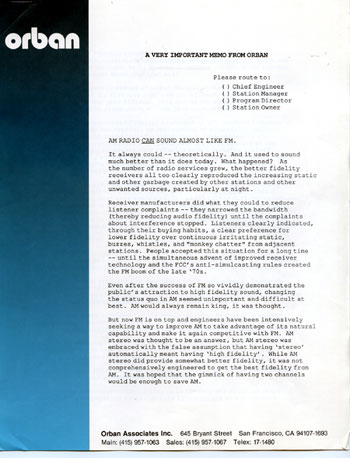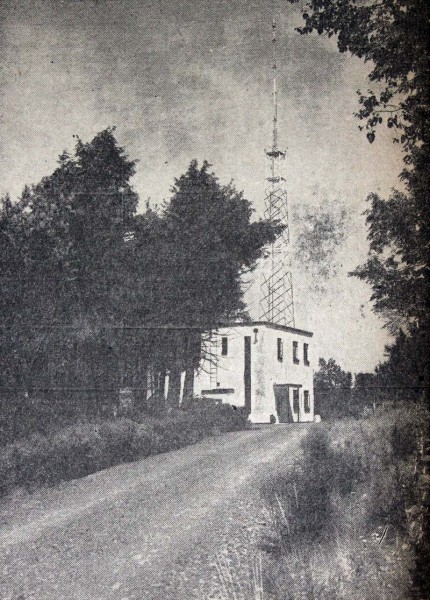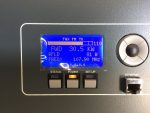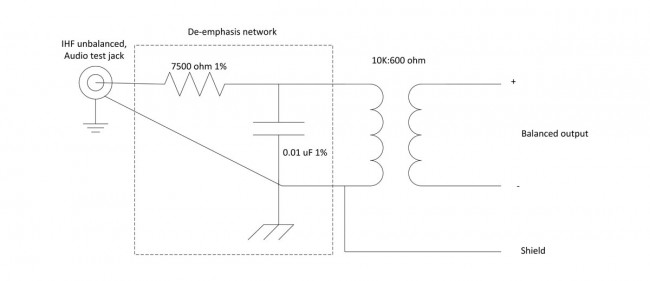I was digging through some old manuals at the shop today and I found this June 1987 memo from Orban to AM stations titled “AM radio CAN sound almost like FM.”
The main purpose of the memo was to get AM radio stations to implement the NRSC standard for pre-emphasis and high-frequency roll-off to improve the sound of AM broadcasts on ordinary radios.
I am not sure why the receiver manufacturers never designed an IF filter that would be compatible with NRSC, it seems like a fairly simple design. Instead, what we have is “digital” AM radio (IBOC) which does not work well, and creates many more problems with interference than pre-NRSC broadcasting.
If one were to look at the entirety of AM broadcasting history, one would find some striking parallels with what is happening with IBOC today on both AM and FM.
To start, the NAB began petitioning the FCC to allow more AM broadcasting stations, even as it was known that these stations would create interference with existing stations, especially at night. Still, the NAB persisted and the FCC relented and through the fifties, sixties, seventies, and eighties many more class II and III stations were established on what used to be clear channels (classes I and IA).
Once the AM band was chock full of stuff, they began going to work on the FM band with 80-90 drop-ins.
You see, for the NAB, more radio stations means more dues money, and greater lobbying power because of the larger size of the industry. Then came the deregulation of ownership limits. By this time, Big Group Radio was calling the shots and they wanted more. This led to the great consolidation rush of the late 1990s from which the radio industry is still reeling. The consolidation rush led to highly overpriced radio stations being leveraged to the absolute maximum, leading to recent bankruptcies.
Finally, the NAB’s great push toward adopting IBOC digital radio in the early years of the 00s. IBOC was supposed to save the day, greatly improving the quality of both AM and FM and bringing radio into the 21st century. Except that the promised technical advances never materialized. IBOC remains a great expensive boondoggle and I am beginning to think that perhaps we should stop listening to the NAB.
The memo itself is a fascinating thing, which was one could substitute AM with RADIO and come to some of the very same conclusions today regarding analog and IBOC digital radio. For example, this paragraph on AM stereo:
AM stereo was thought to be an answer (to improve AM), but AM stereo was embraced with the false assumption that having ‘stereo’ automatically meant having ‘high fidelity’. While AM stereo did provide somewhat better fidelity, it was not comprehensively engineered to get the best fidelity from AM. It was hoped that the gimmick of having two channels would be enough to save AM.
AM stereo could have been an improvement, had it been properly implemented. Unfortunately, the underlying problem of bad-sounding receivers was never addressed. About which, the same memo notes:
Receiver manufactures did what they could to reduce listener complaints – – they narrowed the bandwidth (thereby reducing audio fidelity) until the complaints about interference stopped. Listeners clearly indicated, through their buying habits, a clear preference for lower fidelity over continuous irritating static, buzzes, whistles, and “monkey chatter’ from adjacent stations. People accepted this situation for a long time – – until the simultaneous advent of improved receiver technology and the FCC’s anti-simulcasting rules created the FM boom of the late 1970’s. (ed note: I remember listening to FM because there were fewer commercials, not better sounding audio)
Then the memo goes on to stress the importance of implementing NRSC standard for AM broadcasting that included the sharp frequency roll-off at 10 kHz, noting that receiver manufacturers would design “fine new receivers” that would take full advantage of the new standard, but only if broadcasters first showed good faith by widely and promptly implementing it.
As I recall, NRSC-1 was adopted as a rule of law by the FCC in 1989, about two years after this memo was written. One could reasonably expect that receiver manufacturers then started producing radios that took advantage of the NRSC pre-emphasis curve with IF filters that did not cut off audio frequencies above 3.5 kHz, but rather rolled them off in a gentle slope until about 7 kHz, more aggressively after that until 10 kHz, where they cut off.
Except they didn’t.
Instead, twenty years later, AM radios universally sound bad, with an audio bandwidth of about 3 kHz or so.
I believe that AM receivers could be made with three IF bandwidths, automatically selected based on signal strength. Within the 5 mv contour, full (10 kHz) audio can be reproduced using a high-frequency roll-off described above. In the 1 – 5 mv contour, a 6 kHz bandwidth and less than 1 mv a 3 kHz bandwidth. The automatic selection could be defeated with a “wide/narrow” IF bandwidth selection switch like the GE super radios have. Of course, if one were listening to stations transmitting AM IBOC, the “narrow” setting would be the best.
Half of me thinks that the ship has already sailed on AM broadcasting. The stations on the air will continue to decline until they are no longer able to broadcast due to expensive repairs or replacement, at which time they will be turned off. The other half thinks that AM radio, as evidenced by the huge public response to WEOK and WALL broadcasting the true oldies channel, can be revived. With the impending inevitable FM IBOC power increases, translator shoe-ins, LPFM, etc; the FM band may become worse than the AM band. At this point, the public will have to decide whether free radio is important to them, or 3G/4G services will become the new method of broadcasting.







Very interesting comments. When government and big business (lobbyists) get together and agree on things, the day of reckoning is usually right around the corner. I was never a fan of any NRSC mandate. The AM band sounded better overall prior to this mandate. And certain audio processors have also aggravated transmission quality along with some newer transmitters that just don’t sound right in my opinion. The old FCC Rules on minimum standards for proof of performance seemed fine at the time and it wasn’t until the competition from FM started gnawing away at AM listeners, that the knee-jerk reaction that something had to be done immediately was incorporated into the FCC Rules. Many naive or non-engineering type stations stupidly signed long term contracts with Ibiquity and are stuck paying even if they turn it off. So, we will have to wait and see what will be. I spoke to the CE of a local station where I worked as a college student yesterday, and even though they purchased an Ibiquity license for their AM, he is not going to implement it. I asked him about his three FM-HD stations and he reports that they have received ZERO comments from the listeners about it. Considering that his 96.5 and 102.9 are top rated, Ibiquity seems like a bad investment.